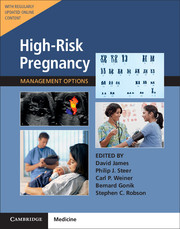Book contents
- Frontmatter
- Contents
- List of Contributors
- Preface
- Section 1 Prepregnancy Problems
- 1 Constitutional and Environmental Factors Leading to a High-Risk Pregnancy
- 2 Domestic Violence in Pregnancy
- 3 Female Genital Mutilation and Pregnancy
- 4 Genetics, Risks of Recurrence, and Genetic Counseling
- Section 2 Early Prenatal Problems
- Section 3 Late Prenatal – Fetal Problems
- Section 4 Problems Associated with Infection
- Section 5 Late Pregnancy – Maternal Problems
- Section 6 Late Prenatal – Obstetric Problems
- Section 7 Postnatal Problems
- Section 8 Normal Values
- Index
2 - Domestic Violence in Pregnancy
from Section 1 - Prepregnancy Problems
- Frontmatter
- Contents
- List of Contributors
- Preface
- Section 1 Prepregnancy Problems
- 1 Constitutional and Environmental Factors Leading to a High-Risk Pregnancy
- 2 Domestic Violence in Pregnancy
- 3 Female Genital Mutilation and Pregnancy
- 4 Genetics, Risks of Recurrence, and Genetic Counseling
- Section 2 Early Prenatal Problems
- Section 3 Late Prenatal – Fetal Problems
- Section 4 Problems Associated with Infection
- Section 5 Late Pregnancy – Maternal Problems
- Section 6 Late Prenatal – Obstetric Problems
- Section 7 Postnatal Problems
- Section 8 Normal Values
- Index
Summary
Introduction
There has been a growing awareness of the importance of domestic violence as a significant public health issue since the late 1990s, although women have been controlled and assaulted by their partners throughout history. Obstetricians, gynecologists, and midwives have a key role in identifying women who are experiencing domestic violence, documenting the abuse, and ensuring that appropriate advice, support, and interventions can be accessed. Domestic violence is one part of a spectrum of human rights abuses against women and girls that includes rape and sexual abuse, sexual harassment and intimidation at work, “honor killings,” female genital mutilation, trafficking of children and women for prostitution, and systematic rape as a tool of war. Gender-based violence is predominantly inflicted by men upon women and girls; it reflects and reinforces inequalities between men and women and adversely affects the health, dignity, safety, and autonomy of survivors.
Domestic abuse is defined by the UK Home Office as “any incident of threatening behavior, violence or abuse (psychological, physical, sexual, financial or emotional) between adults who are or have been intimate partners or family members, regardless of gender or sexuality.” Throughout this chapter the expressions domestic violence and domestic abuse are used interchangeably.
Domestic violence is rarely an isolated incident, and the abusive behavior often begins insidiously, growing more oppressive and harmful with time. In most cases, violence is directed toward a woman by her male partner. Women are more likely than men to sustain physical injuries, experience repeated assaults, report fear and emotional distress, and seek medical attention as a result of the violence. This chapter deals with violence by men against female partners during pregnancy.
Prevalence
In the 2013/2014 Crime Survey for England and Wales, 4.6 million (28%) women aged 16–59 reported a history of domestic abuse since the age of 16, while 1.1 million (6.8%) reported domestic abuse by partners in the preceding year. Similar rates have been reported in surveys from Canada and the United States. However, it is notable that higher rates of domestic violence (40%) have been disclosed in clinical settings.
- Type
- Chapter
- Information
- High-Risk Pregnancy: Management OptionsFive-Year Institutional Subscription with Online Updates, pp. 35 - 45Publisher: Cambridge University PressFirst published in: 2017



